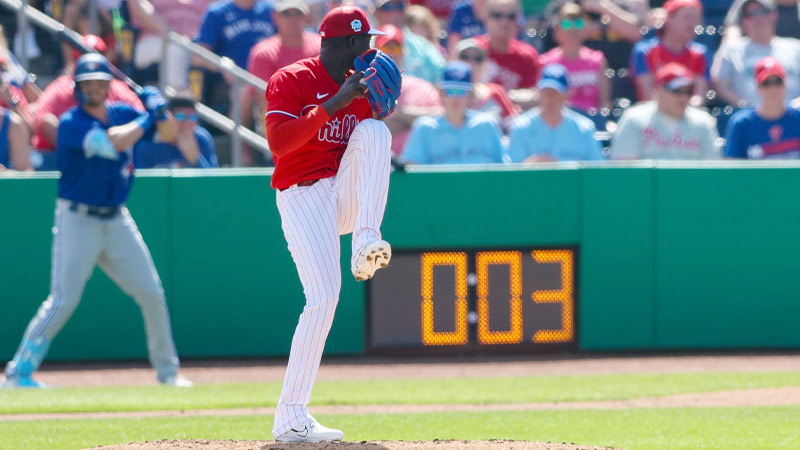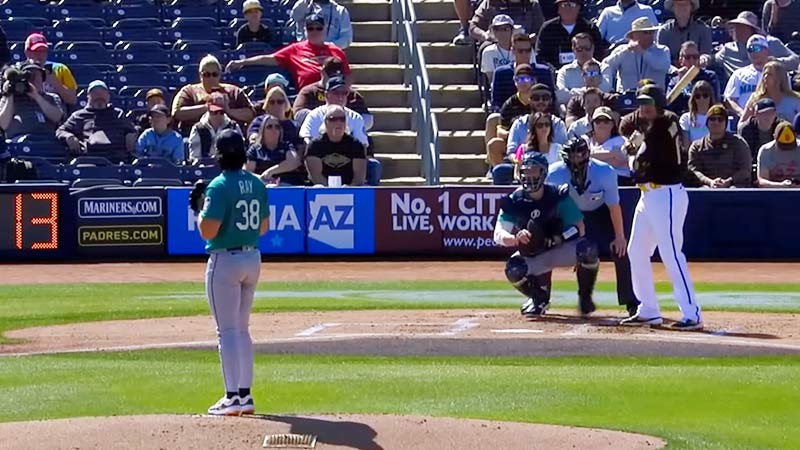Major League Baseball (MLB), often regarded as America’s favorite pastime, has continuously evolved over the years to adapt to the changing preferences of fans and improve the overall game experience.
One significant development aimed at enhancing the pace and excitement of baseball is the implementation of pitch clock rules.
In this blog post, we delve into the significance of MLB pitch clock rules, addressing some frequently asked questions to shed light on how they impact the game and its stakeholders. So, join us in this discussion to learn about the fact in detail.
What Are the Pitch Clock Rules?
Pitch clock rules are a set of regulations implemented in baseball to speed up the pace of the game. The concept of a pitch clock is not entirely new, as it has been used in various leagues and tournaments as an experimental measure to address the issue of prolonged games.
The rules surrounding pitch clocks aim to reduce downtime between pitches and ensure a more fluid and efficient game flow. The basic premise of pitch clock rules is straightforward: pitchers must deliver their pitches within a specified time limit once they receive the ball.
If they fail to do so, a violation is called, and penalties may be imposed. The precise time limit can vary depending on the league or level of play, but it typically ranges from 15 to 20 seconds.
The introduction of pitch clocks has several intended benefits. First and foremost, it helps maintain a brisk tempo throughout the game, keeping players engaged and maintaining the interest of fans.
By minimizing the time spent between pitches, pitch clocks reduce the overall duration of games, which can be particularly appealing to casual viewers who may find extended games monotonous.
Moreover, shorter games can also have practical advantages, such as enabling teams to schedule doubleheaders more effectively or reducing strain on pitchers’ arms by reducing idle time on the mound.
Changed for of MLB Pitched Clock Rules
The MLB pitch clock rules have been implemented to increase the pace of play and ensure a smoother flow of the game. Under these rules, both pitchers and hitters are required to adhere to specific time limits during each at-bat.
When there are no runners on base, pitchers are given 15 seconds to deliver a pitch after receiving the ball back from the catcher.
This time limit starts as soon as the pitcher receives the ball, and they must begin their motion to deliver the pitch before the expiration of the 15-second clock. Failure to do so will result in the pitcher being charged with a ball.
However, when there is a runner on base, pitchers are given a slightly longer time limit of 20 seconds to throw a pitch. This allows them a bit more time to focus on the base runner and make necessary adjustments in their delivery.
Similar to the rule for bases empty, the pitcher must start their motion before the 20-second clock runs out; otherwise, a ball will be charged.
On the other hand, hitters have their own time limit to adhere to. They are required to be in the batter’s box with eight seconds remaining on the pitch clock.
If the batter delays entering the box and fails to be ready within the given time, it will be charged with a strike.
Situations When the MLB Pitch Clock Rules
Pitch clock rules are typically enforced in specific situations during a baseball game. While the exact circumstances may vary depending on the league or level of play, here are some common situations when pitch clock rules come into effect:
- Bases Empty: When there are no runners on base, the pitch clock is often activated as soon as the pitcher receives the ball back from the catcher.
- Restarting the Pitch Clock: The pitch clock is reset when the pitcher steps off the rubber, attempts a pickoff throw, or engages in certain other actions that require resetting the timer.
- Runners on Base: In many cases, pitch clock rules are paused or deactivated when there are runners on base. This allows pitchers to focus on holding runners or making pickoff attempts without the added pressure of a ticking clock.
- After Foul Balls: Following a foul ball, the pitch clock is often reset to allow the pitcher ample time to regroup and prepare for the next delivery. It’s important to note that the specific application of pitch clock rules can vary between different leagues and levels of play.
While some leagues may enforce pitch clock rules consistently throughout the game, others may implement them only during certain innings or time periods, such as during the later stages of a game or in specific tournaments.
It’s always recommended to consult the specific rules and regulations of the league or organization in which the game is being played to determine the exact situations when pitch clock rules are applied.
Penalties For Breaking MLB Pitch Clock Rules

Source: frontofficesports.com
When a pitcher fails to adhere to pitch clock rules, penalties are typically imposed by the umpires. The exact penalties may vary depending on the league or level of play, but here are some common consequences for breaking pitch clock rules:
Ball Awarded to the Batter
One of the most common penalties is awarding a ball to the batter. If the pitcher fails to begin the delivery within the allotted time, the umpire may call a ball, adding to the pitch count of the batter. If four balls are awarded, the batter is then granted a walk and proceeds to first base.
Warning and Subsequent Violations
In some cases, the first violation of the pitch clock rules may result in a warning to the pitcher or the team.
This warning serves as a reminder to adhere to the time limit. However, subsequent violations can lead to penalties, such as awarding balls to the batter or other consequences outlined in the league’s rules.
Fines or Ejections
In certain professional leagues, repeated or deliberate violations of pitch clock rules can result in fines imposed on the pitcher or even ejections from the game.
These measures are meant to deter pitchers from consistently disregarding the time limit and to ensure compliance with the rules.
It’s important to note that the specific penalties for breaking pitch clock rules can vary across different leagues and levels of play. Additionally, the enforcement and severity of penalties may be subject to interpretation by the umpires.
It’s advisable for players, coaches, and umpires to familiarize themselves with the specific rules and regulations of the league or organization in which the game is being played to understand the consequences of violating pitch clock rules.
Significance of MLB Pitch Clock Rules
The implementation of pitch clock rules in Major League Baseball (MLB) carries several significant implications for the game. Here are some key points highlighting the significance of pitch clock rules in MLB:
Enhancing the Pace of Play
One of the primary motivations behind pitch clock rules is to address the concern of extended game durations.
Baseball has historically been known for its leisurely pace, but this has led to criticisms that games can become lengthy and drag on, potentially reducing fan engagement.
Pitch clocks help ensure a steady tempo, reducing downtime between pitches and expediting the overall pace of play. This can make the game more exciting, appealing to both existing fans and potentially attracting new ones.
Streamlining Broadcasts and Commercial Breaks
Shorter game durations resulting from pitch clock enforcement can also benefit broadcasters and advertisers.
With a more efficient pace, broadcasts can better adhere to schedule, allowing for more predictable commercial breaks and smoother transitions. This can improve the viewing experience for fans and contribute to a more streamlined and engaging telecast.
Improving Player Focus and Engagement
Pitch clocks impose a sense of urgency on pitchers, encouraging them to be prepared and ready to deliver their pitches promptly.
This can enhance their focus and engagement during the game, reducing idle time and maintaining their competitive rhythm. Similarly, batters benefit from a quicker pace as it minimizes the time they spend waiting for pitches, allowing them to stay engaged and maintain their timing and rhythm.
Encouraging Aggressive Play
Pitch clock rules can incentivize more aggressive play by both pitchers and batters. Pitchers may be compelled to work faster, limiting the time for opposing batters to adjust and potentially disrupting their timing.
On the other hand, batters have less time to step out of the batter’s box and engage in prolonged rituals, creating a sense of urgency and encouraging more proactive approaches at the plate.
Reducing Fatigue and Injury Risks
Extended games can lead to increased fatigue, especially for pitchers who spend significant time on the mound.
By shortening the overall game duration, pitch clock rules can help mitigate excessive strain on pitchers’ arms and bodies, potentially reducing the risk of injury. This aspect is particularly crucial for player health and player management strategies employed by teams throughout the season.
It’s worth noting that the implementation of pitch clock rules in MLB has been a topic of ongoing discussion and experimentation.
While they have been tested in the minor leagues and spring training games, their use in regular-season MLB games remains a subject of negotiation between the league and the players’ union.
The ultimate goal is to strike a balance between maintaining the integrity of the game and addressing the desire for a more streamlined and time-conscious experience for fans and stakeholders.
FAQs
What are pitch clock rules in MLB?
Pitch clock rules in MLB impose a specific time limit on pitchers to deliver their pitches once they receive the ball. Typically ranging from 15 to 20 seconds, the pitch clock ensures a steady tempo and minimizes downtime between pitches, expediting the overall pace of play.
Why were pitch clock rules introduced in MLB?
The introduction of pitch clock rules in MLB aims to address concerns regarding prolonged game durations. By reducing downtime and expediting the game, pitch clock rules enhance the overall pace of play, making it more engaging for fans and potentially attracting new audiences.
How are pitch clock violations penalized in MLB?
When a pitcher fails to adhere to the pitch clock rules, penalties can be imposed by the umpires. Common penalties include awarding a ball to the batter, issuing warnings, and, in some cases, fines or ejections for repeated or deliberate violations.
What impact do pitch clock rules have on player performance?
Pitch clock rules create a sense of urgency for pitchers, encouraging them to be prepared and focused, thus potentially enhancing their performance. Batters also benefit from a quicker pace as it reduces the time spent waiting for pitches, allowing them to stay engaged and maintain their timing and rhythm.
How do pitch clock rules affect the viewing experience?
Pitch clock rules streamline the game, resulting in shorter game durations. This benefits broadcaster and advertisers, allowing for more predictable commercial breaks and smoother transitions during broadcasts.
Additionally, the quicker pace keeps fans engaged and maintains excitement throughout the game.
Wrapping Up
The implementation of pitch clock rules in MLB represents a significant step towards enhancing the pace and excitement of America’s favorite pastime.
By reducing downtime, streamlining broadcasts, and fostering a sense of urgency, these rules improve the overall game experience for players and fans alike.
While the impact and acceptance of pitch clock rules continue to be subjects of discussion, their significance in modernizing and refining the game of baseball cannot be denied.
As baseball embraces new innovations, pitch clock rules stand as a testament to the sport’s willingness to adapt and evolve while preserving its timeless charm. Thanks a million, folds for your time.







